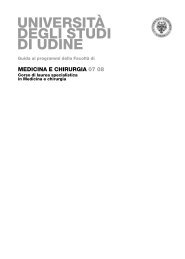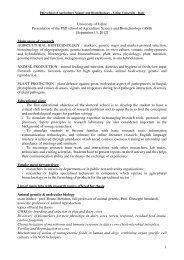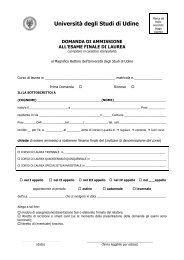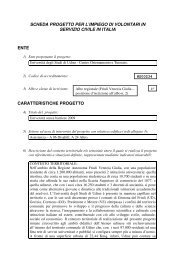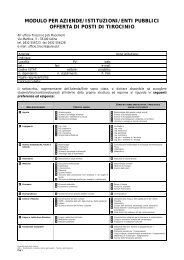â¢GUIDA ECONOMIA 07-08 - Università degli studi di Udine
â¢GUIDA ECONOMIA 07-08 - Università degli studi di Udine
â¢GUIDA ECONOMIA 07-08 - Università degli studi di Udine
Create successful ePaper yourself
Turn your PDF publications into a flip-book with our unique Google optimized e-Paper software.
prospectus u<strong>di</strong>ne<br />
173<br />
BUSINESS ECONOMICS<br />
(CdL BE, EBAI)<br />
Prof. Franco Cescon<br />
(CdL BF, EC, SCSBM)<br />
Prof. Andrea Garlatti<br />
Aims<br />
The aim of the course is to introduce students<br />
to economics for business and to<br />
the problems of accounting, organisations,<br />
governance and the market system.<br />
Contents<br />
The course examines economics for business<br />
as a central part of the framework of<br />
Business Stu<strong>di</strong>es. Topics covered include:<br />
1. Economics for Business and firm activities;<br />
2. The Firm: Concepts and Classifications;<br />
3. Business and the Environment;<br />
4. The Business Economics Framework;<br />
5. Corporate Governance;<br />
6. Accounting and Organization of<br />
Process and Products;<br />
7. Financial Position: Assets, Liabilities<br />
and Equity;<br />
8. Principles of Corporate Finance and<br />
Control;<br />
9. Corporate Reporting and Value of<br />
Companies.<br />
Bibliography<br />
- G. AIROLDI, G. BRUNETTI, V. CODA,<br />
Economia Aziendale, il Mulino, Bologna,<br />
reprint 2005; Le aziende (part 1: chps. I,<br />
II and III); La struttura delle aziende (part<br />
2: chps. V, VI, VII and VIII); L’economicità,<br />
il red<strong>di</strong>to e il capitale (parte terza:<br />
chps. IX, XIII).<br />
- F. CESCON, A. GARLATTI, Economia aziendale<br />
- casi e testi, Cedam, Padova, 2005.<br />
Teaching arrangements<br />
Lectures and tutorials.<br />
Exam<br />
There is a two hour written examination.<br />
BUSINESS INFORMATION SYSTEMS<br />
Prof. Maurizio Pighin<br />
Aims<br />
The aim of the course is to provide students<br />
with the basics on Business Information<br />
Systems, with a particular attention<br />
to the Operative Systems. The structure<br />
of an ERP system is described in<br />
detail, analysing its principal processes:<br />
administration, logistics, purchasing, selling,<br />
production. The principal informatin<br />
structures and fundamental functions<br />
in every flow are identified. Case <strong>stu<strong>di</strong></strong>es<br />
are introduced to describe the general<br />
models.<br />
Contents<br />
Introduction. General concepts of business<br />
informatics - Impact of ICT on<br />
enterprises.<br />
Enterprise Structure and its Information<br />
System. Decomposition of information<br />
systems.<br />
Operational Systems. Targets - Operational<br />
information - Methodology of data<br />
and process representation.<br />
Basis and Complementary Operational<br />
Systems. General concepts - ERP - Extensions<br />
of ERP - Technical systems - Office<br />
and organisation systems.<br />
ERP: Accounting. Targets - Basis structure<br />
and procedures - Advanced flows.<br />
ERP: Logistics. Targets - Basis structure<br />
and procedures - Advanced flows.<br />
ERP: Selling. Targets - Basis structure and<br />
procedures - Advanced flows.<br />
ERP: Purchase. Targets - Basis structure<br />
and procedures - Advanced flows.<br />
ERP: Production. Targets - Basis structure<br />
and procedures - Advanced flows.<br />
Informational Systems (hints). Data<br />
Warehousing and Data Mining general<br />
concepts.<br />
Bibliography<br />
Textbooks<br />
- M. PIGHIN, A. MARZONA, Sistemi Infor-




